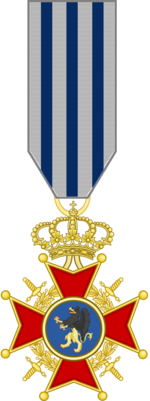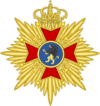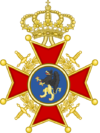Elizabeth Cross
| Elizabeth Cross | |
|---|---|
 | |
| Awarded by Sovereign of Aquitayne | |
| Type | Military decoration |
| Eligibility | Persons of any rank in the Naval, Military and Air Forces of the Aquitayne or the United Kingdom, its colonies or territories, and friendly countries that may award Aquitaynian honors; members of the Merchant Navy; and civilians serving under the orders, directions or supervision of any of the above-mentioned forces or services. |
| Awarded for | "... for extraordinary actions above and beyond the call of duty, at great peril to one's own life." |
| Status | Currently awarded. |
| Description | Red Maltese cross with Crown and Griffin Superimposed, and motto: 'For Country' |
| Post-nominals | EC |
| Statistics | |
| Established | 24 April 1828 |
| First awarded | 15 August 1830 |
| Last awarded | 22 September 2014 |
| Total awarded | 1,902 |
| Distinct recipients | 1,902 |
| Order of Wear | |
| Next (higher) | None |
| Next (lower) | Urimanus Cross |
Ribbon bar | |
The Elizabeth Cross (EC) is Aquitayne's highest military honor, awarded for personal acts of valor above and beyond the call of duty. The medal is awarded by the Sovereign of Aquitayne in the name of the Aquitaynian people to Aquitaynian or United Kingdom military personnel only. There is only one variation of the medal, which has existed since its creation by Queen Elizabeth on the 24th of April, 1828. The post-nominal title for the Elizabeth Cross is simply EC. The only person legally permitted to give final approval and issuance of the Elizabeth Cross is the sovereign of Aquitayne, who has hand-given every Elizabeth Cross to each living recipient since its inception. Many times this is done during a larger medal awarding ceremony where the monarch awards the higher honors of the military services to many individuals, but on rare occasions of extreme valor, lone Elizabeth Cross award ceremonies have been held.
The Elizabeth Cross was created by Queen Elizabeth to honor soldiers who had fought in previous wars as well as the more recent ___ conflict. After the medal's creation, Queen Elizabeth ordered the military staff to compile a registrar of applicable soldiers who were deserving of the award whether they be living or deceased. On the 15th of August 1830, the largest issuing of the Elizabeth Cross occured when 120 men - going as far back as the War of Independence - had their awards upgraded or issued posthumously to the Elizabeth Cross. It was reported that only eleven living recipients were given the Elizabeth Cross during this issuance, and the medals from this round of issuance are the most sought after for collectors.
Member-states of the United Kingdom are eligible to receive the Elizabeth Cross if their actions were in defense of, or on behalf of Aquitaynian soldiers or the Aquitaynian monarch. The only exception to this rule is that it is permitted to be issued to soldiers of the former Aquitaynian colony of Aswick, with whom the nation has retained strong ties. Since Aswick's independence from Aquitayne in 1925, only 2 Aswickans have been awarded the Elizabeth Cross for acts of valor in defense of Aquitayne or the United Kingdom.
Origin
Appearance
The appearance of the Elizabeth Cross comes in three distinct forms: The First, Second, and Third classes. The overall appearance of the medal itself however does not change between grades. The base of the medal, and the entirety of the Third Class cross, is a red Maltese cross with a blue circular center and the national animal, the Griffin, superimposed on the face. The Crown of Aquitayne sits at the top of the cross and rests in front of the ribbon clasp on the first two grades where it is worn as such.
The Elizabeth Cross Second Class has two additional distinct features about it. The most notable feature is the 24 karat gold wreath that goes around the inside of the cross, with four crossed swords behind the wreath as well. These markings make distinction for acts of extreme valor in combat.
The Elizabeth Cross First Class is the rarest of all grades, and is the most grand. The medal itself, accompanied by the golden wreath and crossed swords, is superimposed on a 24-karat gold chest badge. This version of the medal is not worn with a ribbon on the left side of the chest, but is rather pinned to the shirt or jacket of the wearer on the right side above their nameplate, to signify its highest regard and respect.
Award process
Classes
| Grades of the Elizabeth Cross | |||||
|---|---|---|---|---|---|
 EC First Class |
 EC Second Class |
 EC Third Class | |||
| Ribbon bars of the Elizabeth Cross | |||||
|---|---|---|---|---|---|
EC First Class |
EC Second Class |
EC Third Class | |||
Authority and privileges
As the highest award for valor in Aquitayne and the United Kingdom, the Elizabeth Cross is always the first award to be presented at an investiture, even before knighthoods, as has been common practice since the late 19th century. Owing to its gravitas and importance, the Elizabeth Cross is always worn as the first medal by any recipient, and is always the first set of post-nomial letters used to indicate any decoration or order. Similar acts of valor that may not warrant the Elizabeth Cross or do not take place in the face of the enemy may be awarded via the Urimanus Cross, which has lower precedence but is the only other Crown Decoration.
After the creation of the Elizabeth Cross, due to its rarity, it became common practice for military personnel to salute anyone they saw wearing the award. Though it was not required of them, the practice remained invested in the military and famously was upheld by General Ser Edward Calvis, who was seen saluting a private who had been awarded the medal. In 1898, the Ministry of War declared that "any persons in uniform who cross paths with or engage with any other persons in uniform or civilian attire bearing the ribbon or medal of the Elizabeth Cross will render salute." As such, should the Grand Field Marshal of the Army cross paths with a private who has been awarded the Elizabeth Cross, he is required to render a hand salute.
Annuity
The original warrant for the creation of the Elizabeth Cross declared that recipients would be awarded 20 Aero annuity per annum. In 1910, just before the onset of the Great Astyrian War, King Tiberius Reich raised the yearly annuity to 75 Aero for those who could not make their own livelihood due to infirmity, sickness, or old age. Today, recipients are still entitled to a yearly annuity in the amount of 11,000 Aeros that remains tax-exempt. They are also given free healthcare and medical procedures for the rest of their lives, with great care taken to ensure they receive the greatest medical care possible if their injuries will effect their quality of life.